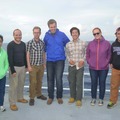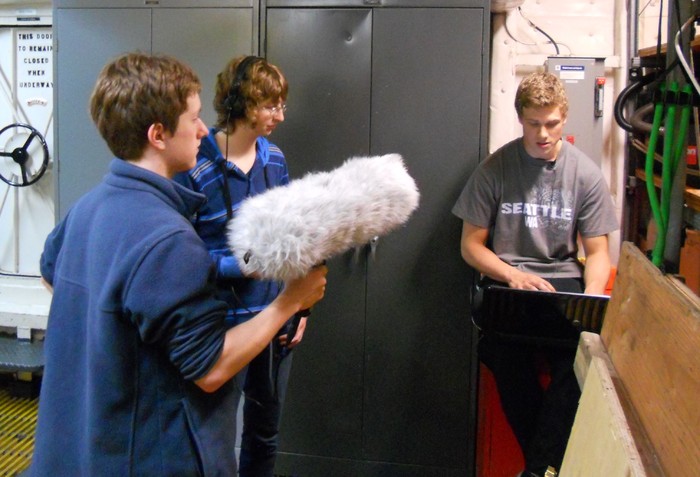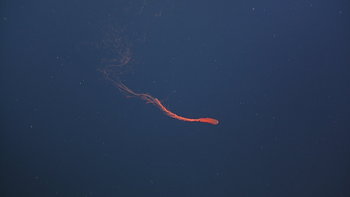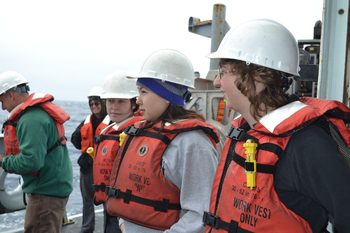26 July 2014
ROPOS has come out of the water just minutes before my watch the last two days. Not having watch took a little getting used to, but with all the extra time we were able to make a lot of head way with our projects. The video looks great and needs very little done before it can be considered fully finished. The catalog is also really coming along, it has tons of pictures and we’ve been working hard to fill it up with interesting information about the animals. The next challenge for the catalog will be isolating and creating short video snippets. The clips will show how these animals move and interact with their environment, something pictures alone can’t do.
A real highlight of last night was going out after dark and looking at the stars. I had been out a few times when it was just starting to get dark, and had been able to see quite a few stars. But that was nothing compared to going out after it was fully dark. Seconds after getting to the bow and letting my eyes adjust, the sky was bursting with stars like I’ve never seen before. The Milky Way popped out right away, and shooting stars and satellites were all around. It was like being in a planetarium but so much better. The view was very much worth the bruised shins I got by walking into a post while I still couldn’t see.
25 July 2014
Sleeping on the Thompson has been a unique experience. The students are all in the forward science berths. Which means the rooms have no windows, and we’re right above the bow thruster. At night and in the morning the rooms are black with the only light being what comes in from under the door. This makes falling asleep great, but getting up can be difficult. As someone who has come to rely on the sun as a gentle alarm clock, I’ve woken up more than once disoriented and confused about what time my watch is showing me. Being up front also means that during transit, the night is punctuated by the slapping of the waves and what we’ve been told is the booming crash of the anchor against the side of the ship, which doubles as the cabin’s wall. In the rougher conditions this knocking has been hard enough to rattle the bunks. When we’re on station nights are no longer marked by tremendous bangs, but are instead full of the sound of the bow thruster. This important contraption stabilizes and keeps the ship fixed on location, and while it is constant and adept at its job, I question the necessity of placing it right below our rooms. Despite the thruster’s continuous racket I prefer it to the noises during transit. It may be noisy, but it’s consistent, which trumps the unpredictable booms of a giant trying to knock down my metal wall.
24 July 2014
The last couple of days have been spent reworking our video script and recording the narration. Constant throughout this process has been the noise. It shouldn’t have come as such a big surprise that no place on board is actually quiet, but it wasn’t until we started looking for a relatively quiet area in which to record, that I realized there was always some sort of background sound. In the cabins you can hear the ventilation. The main lab is noisy with the hubbub of life and work. Outside there’s wind, and noise from a busy deck. The hold in the bow is rattled by the sounds from the thruster below. And with the rougher weather we’ve been having lately, the sound of waves slapping against the ship is constant almost everywhere you go. Despite this unforeseen challenge we were able to record multiple takes of our audio, which has really helped us edit and streamline our video as a whole. Most of our work from here on out with the video will be final edits and embellishments, giving us more time to focus on the catalog which is also moving forward in leaps and bounds.
21 July 2014
Yesterday’s ROPOS watch was a unique experience. The goal of the dive was simply to deliver a junction box to the seafloor, so we were able to get in and out of the water in only a few hours. Seeing a dive through from beginning to end meant we spent most of the time traveling down and back up, which amounts to just watching the water rush by. Depending on the time of day and location these trips up and down the water column can be quite boring. But we lucked out and were able to see some interesting animals on our way by.
These sightings and subsequent photographic images are doubly exciting for me since I’m working with Jesse and Sam to compile a catalog of the animals that call this area their home. Our goal is to create a database with the species seen throughout the RSN’s construction and by the RSN equipment. The work so far has been mostly searching through previous year’s footage, as well as this year’s footage as it comes in, and pulling good quality images out. We’ve also been working on writing brief descriptions on the species. This has been a continuous process throughout the last week, but our hard work is paying off. On top of the catalog we’re working to put together a brief introductory video to the ecosystem that makes life in this area possible. That video has progressed nicely and most of the footage has been compiled and is awaiting narration and final edits.
19 July 2014
Yesterday was full of activities. Besides the near constant work on our own project, the other students and I had a tour of the engine room as well as our daily talk. While I couldn’t hear much over the roar of the engines on the tour, just having a look around all of the pipes and machines gave me a much better perspective on what makes everything we do on board possible. After the tour, and a short break to let the ringing in our ears clear out, we sat down with Deb for a couple of hours and discussed hydrothermal vent systems and why there is an interest in studying them more thoroughly. The last few days’ worth of talks have been focused on attempting to give us a better understanding of the project we’re out here trying to complete, and the environment we’re working in. At the end of the talk my watch started, and at the end of those four hours as ROPOS was ascending, the science party had a meeting to make sure everyone was up to date on everything currently happening on board. After all that was over, it was again time to work on our biology catalog and video. All of our hard work on that front is starting to pay off, and the project is quickly taking form.
15 & 16 July 2014
We’ve been at Axial for about two days now, although we’ve only been able to put ROPOS in the water for one dive since the weather hasn’t been cooperating with us. Despite that, I did get to sit my first watch in the afternoon of the first dive. It was quite exciting even if each operation has to be handled slowly and carefully. Even though the weather kept ROPOS out of the water it didn’t keep us from making Conductivity, Temperature, Depth (CTD) casts. The CTD has a rosette of 24 Niskin bottles that can be triggered from the ship to take water samples from various depths. Even though I had some experience with taking these samples, it was novel to do them in water this deep since it takes quite a bit more time to descend 2500m than it does to go 60m.
Despite the CTDs and other minor projects happening throughout the ship, Wednesday was much slower than Tuesday. We tried to take advantage of the down time to keep moving forward on our student projects. Jesse, Sam, and I have made some great progress with the time and are hoping to be able to start mocking up videos and the catalog during the next couple of days. The ship is a great place to work on projects, directly related to the cruise or not, because there are so many people with different backgrounds and skill sets. Everyone is happy to be a sounding board and offer their own expertise to help solve problems.
14 July 2014
Sunday started with getting up to catch the sunrise over Seattle. The rest of the day was marked by exploring the ship, helping stow equipment and boxes, doing safety drills, and learning emergency procedures. Throughout all of this, I’ve met and talked with all kinds of different people on board, discussed ideas for student projects, and listened to the first two hours of John Delaney’s hour and eleven minute presentation. The ship itself made most of the trip from Seattle to the Straits of Juan de Fuca. The scenery along the way was amazing and sunset in the Straits made for some amazing photos.
Monday, again, started early to catch the rest of John’s lecture from the night before. The gentle rocking of most of Sunday’s trip gave way to some rougher conditions as the sun went down. The slapping of waves on the bow was jarring and sleep was a long time coming because of it. The boat’s motion which was barely notable on Sunday made something as simple as getting dressed Monday morning nearly impossible. Walking around the ship – which is slowly becoming less of a confusing maze – now has the added challenge of the boat itself trying to throw you to the ground. Stairwells are by far the hardest areas to navigate. Going up and down, as well as side to side are easily the most disorienting things to have to do. I’m told that this is the worst the motion is going to be for the whole trip, and for my stomach’s sake I hope that it’s true.
During the down time, Jesse, Sam, and I have been trying to work on our project to catalog the biology around Axial Seamount. Since our work depends on what videos and pictures the ROV is able to capture, we’ve been trying to prepare ourselves as much as possible. Mostly by looking at old cruise data to get an idea of what animals we might see, and prioritizing what footage is an absolute must to get. All the prep work has made me eager to get to Axial so we can get started collecting our own data.





